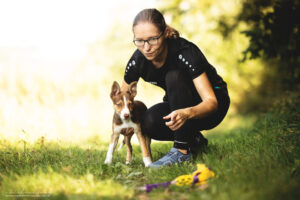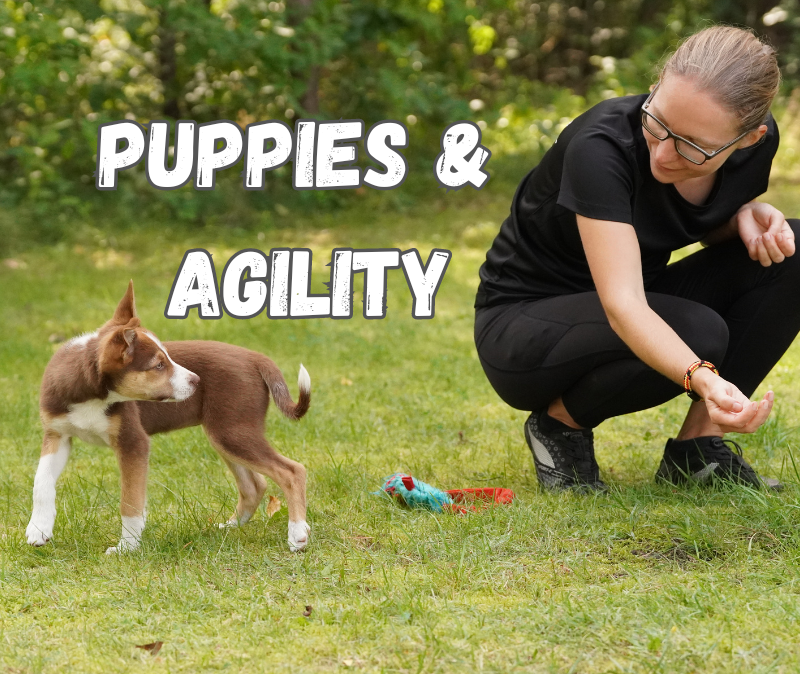Puppies & agility – when and how can my puppy start?
New findings in dog training
In the past, the common belief was: “Wait until your puppy is a year old before you start training.” This view was based on the assumption that younger dogs were not mature enough for structured learning.
Today, however, we have gained a deeper understanding of canine development. We now know: The learning process begins the moment the puppy enters our lives – regardless of whether we are aware of it or not. Every interaction, every new experience shapes the personality and behavior of our new family member.
Imagine your puppy as a small, curious explorer. His brain is like a sponge, eagerly absorbing and processing every experience. From the gentle tone of your voice to the rustling of the treat bag to joyful play in the garden – all these moments are valuable learning opportunities that lay the foundation for a harmonious human-dog relationship.
Practice makes perfect
- Get to know your puppy properly
Find out what your new companion likes and dislikes. This way you can bring fun into every exercise and work on minor insecurities early on. - Make learning the highlight of the day
Discover the joy of learning together with your puppy! Whether in the living room or in the park – learning can happen everywhere. This way, every walk becomes a small adventure. - Use your puppy’s “superpower”
In the first few months, your puppy learns particularly quickly. Use this time to gather great experiences and lay important foundations! - Build an inseparable friendship
Now is the perfect time to build a strong bond. Show your puppy that you’re the coolest person in the world and will always be there for them.

Health comes first – especially in training
Your puppy is like a little superhero in training – their bones and joints still need some time to develop their full strength. That’s why we take it slow and only increase the training when the dog is ready for it. At about one year old, it’s recommended to have an X-ray of the joints taken. The vet gives us the green light for the next training phase!
Training is like cooking – the right mix makes all the difference! Too much action could harm your puppy’s joints, but a certain amount of stress is needed for the development of bones and joints. The challenge lies in finding the perfect balance so that your dog grows up healthy and happy. You can find out more about maintaining balance during training here.
At Agility Campus, we therefore start the foundational training without agility equipment. Later, when your dog is older, we can really get going. Thanks to the strong foundations learned as a puppy, the training will then not only be super effective, but will also be a lot of fun for you and your dog!
Why basics for puppies?
We start with the fundamental elements – the foundation for successful communication between human and dog. This phase is about developing a common language and discovering the world from your puppy’s perspective. The training on agility equipment is introduced at a later stage, when your dog has understood the foundational pieces and is physically ready for it.
Why are these basics so crucial for further training success?
- Your dog develops an impressive learning ability that allows them to quickly grasp new concepts and exercises
- You develop an intuitive understanding in the course – often just a brief eye contact or a quiet command is enough for flawless communication
- Even in an environment full of distractions and stimuli, your dog remains focused and attentive – their eye is on you, no matter what’s happening around you
- Through a clear understanding of the reward system, learning becomes a joyful experience for your dog – they understand the connection between their actions and positive consequences
- Your dog develops independence and the ability to work reliably with you even at greater distances – an important prerequisite for advanced exercises
- The art of staying calm and focused on the start line becomes second nature – a key competence for successful competitions
→ This way, you can teach the agility equipment more quickly when your dog is old enough for it.
Your dog should be able to do this before using the equipment:

What basics should your puppy learn?
The following foundational skills are essential building blocks for your puppy’s future agility training. Think of them as a versatile toolkit that you’ll draw upon when teaching more advanced agility behaviors down the line. Each skill, from understanding rewards to mastering basic commands, contributes to a strong foundation that will make learning complex agility behaviors much easier and more enjoyable for your dog. By focusing on these fundamentals now, you’re setting the stage for a successful and exciting agility journey together.
Before introducing your puppy to agility equipment, it’s crucial to establish a solid foundation of essential skills. Let’s explore the key competencies your dog should master:
- Understanding the reward system (when and where to expect the reward)
- Retrieve toys
- Being familiar with the food machine (Treat Train)
- Being attentive and focused
- Good level of physical coordination
- Good relationship with you and enjoyment of learning
- Interacting creatively with objects (shaping)
- Distinguishing left and right on the flat
In the first few months with your new family member, you’ll have lots of fun training these basics! Our Agility Campus “Basics for Sport Dogs” course is your guide through puppyhood and provides you with many age-appropriate exercise ideas, so that your puppy is equipped with strong basics and perfectly prepared for further training. Are you curious about what comes next? Then take a look at our recommendations with regard to your dogs age:
- From week 8 to month 5/6 → “Basics for sport dogs” (all basics without equipment)
- From month 6 to 9 → “Basics for sport dogs – advanced course” (get to know first equipment, deepen basics)
- From month 9/10 → “Run It” (the dogwalk course, starting with exercises on the flat)
- From month 11 → “In Yo” (Threadle wrap slice, low poles)
- From month 12 → Backside (low bars)
- Important: Now off to the vet for an x-ray! If everything looks good:
- From month 13 → Jumping technique (slowly getting higher)
- From month 14 → “Bang It” (the seesaw course, also starts on the flat) – but only when the dogwalk is already at full height
- From month 15 → Weaves
- From month 16 → A-frame
Remember: This is just a guideline for when I would start with the equipment at the earliest. Every dog is unique and learns at their own pace. This sequence has worked well for me, but feel free to adapt it to your dog!
And don’t forget the most important thing: always have fun training your puppy!
